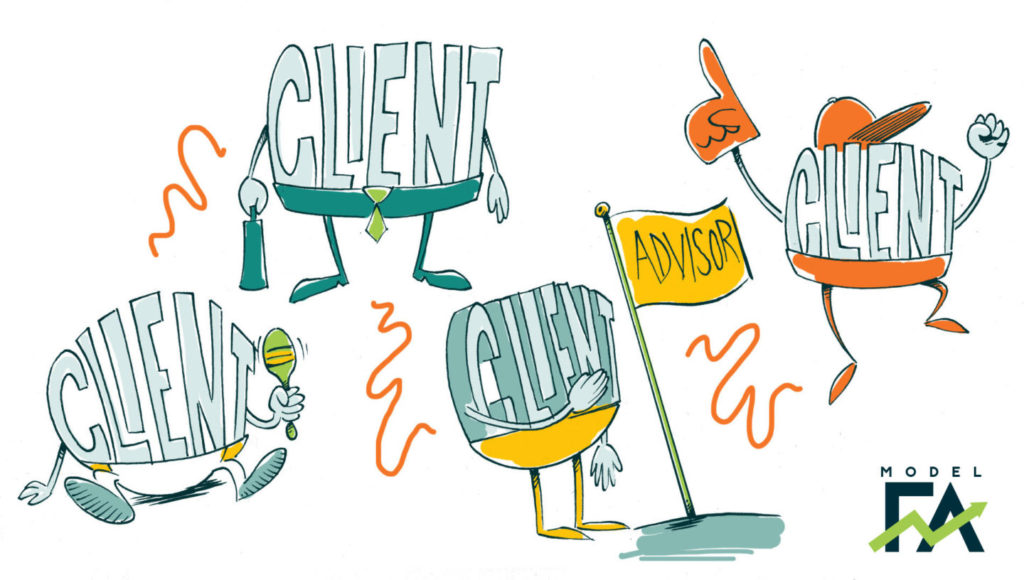Financial advisor-client relationships are built on a foundation of deep trust. Here is a blueprint for strategic trust acceleration.
How do you think about the people that you interact with as a financial advisor?
Most advisors I know divide their world into two categories: prospective clients and actual clients.
That isn’t wrong — but in my experience, looking at financial advisor-client relationships as a binary proposition robs you of an opportunity.
Not all client relationships are created equal.
There is a multi-step journey between signing on a brand-new client — and making them comfortable enough to refer you to friends and colleagues. Most consultants will tell you to just wait a year and ask for referrals. Some people will refer you, some won’t … so you go on playing out the numbers game and hoping that enough people come through.
But that approach leaves something to be desired. Consider looking at client relationships on a spectrum.
- There are new clients who have just completed their onboarding process;
- There are clients who have a good working relationship with you;
- You have some loyal clients who view you as a trusted advisor;
- Finally, there are raving fans.
In his viral essay 1,000 True Fans, Kevin Kelly defines a “true fan” as someone who will buy anything you produce. A true fan might drive 200 miles to watch a favorite band play a gig, reserve a $300 seat at a monthly chef’s table, or buy a Kindle and a hard copy version of the same book to support their favorite writer.
The “raving fan” concept is similar. These clients have experienced your service as “above and beyond” the call of duty. They can’t help but serve as your vocal advocates everywhere they go.
Ravings fans are an enormous asset to your practice because they deliver the kind of marketing that money can’t buy. They can lower your marketing costs. They can improve the organic reach of your practice. Their deep trust can create a cushion of forgiveness in the event of a human mistake on your side — and better endurance through tough market cycles. In other words, raving fans create better outcomes for themselves, other clients, and you as their advisor.
What does it take to move someone from a “new client” to a “raving fan”?
Most people would tell you that it takes time — and solid service.
Again, they aren’t wrong … although not the way they think.
Financial advisor-client relationships aren’t linear. The timeframe of turning a new client into a raving fan doesn’t have to take years. Finally, simply delivering good service isn’t enough.
Instead, you must invest time and energy into moving the client along the trust-building journey in a way that’s intentional and exponential.
Here’s an example. Your first three months of serving a new client are a critical time for your brand-new relationship. This is your opportunity to make an impression, get their buy-in, and build trust. You might think that three months is barely enough time to get their assets transferred in and re-allocated — but if you fail to use this time for relationship-building, you will have missed an opportunity.
So, reach out to your new client proactively. Send a book with a hand-written note. Invite them to an event. Have a coffee or lunch together. Comment on their Facebook post if they buy a new house — and send them a bottle of champagne to celebrate a special occasion.
See also: Building a Financial Advisor Value Proposition that Someone Will Buy
5 Tactical steps to turn your clients into raving fans
How do you apply the “raving fan” concept to an existing book of business — without getting overwhelmed?
Step 1, choose 20 clients.
Step 2, assess where each of those clients stands today on the client relationship scale. Most will land at “new client” or “good working relationship”. You may even have a few loyal clients in the mix.
Step 3, write down the next step in advancing each relationship. What can you do in the next 10 days to move them to the next stage? Remember that in order to make this work, you must identify an action that’s personalized and relevant for that client.
Step 4, do those actions.
Step 5, repeat.
Do this for a year — and watch a solid portion of your client list shift closer to “raving fans”.
But wait, that’s not enough for great client relationships!
Delivering proactive personalized service is an important part of building trust. But there are other parts to that equation.
Trust = Credibility + Reliability + Intimacy
Most advisors score pretty well on credibility. They are CPAs, CFAs, experts in financial planning. Some have written books, authored a column in a local paper, or spoken in the media.
Reliability scores are usually fine, as well. Advisors tend to reply to emails in a timely manner, show up for scheduled appointments and phone calls, deliver reports when promised.
Where many advisors fail is in building intimacy.
Your goal here is to build a human relationship by engaging in “mutuality”. Create opportunities for them to discover that they can ask you for help — and you can do the same. People want to be of service. They want an opportunity to feel great about helping you. So, you need to ask for their help … at the right time.
In my experience, new clients can begin to send you referrals as early as 2 months into the relationship — if you can successfully demonstrate your commitment, dedication, and humanity.
Ever had a client surprise you with a referral “ahead of schedule”? Sound off in the comments!
This article was originally published at ModelFA.com

